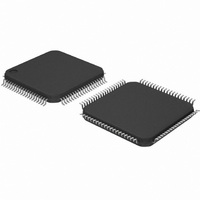DP83849CVS/NOPB National Semiconductor, DP83849CVS/NOPB Datasheet - Page 32

DP83849CVS/NOPB
Manufacturer Part Number
DP83849CVS/NOPB
Description
IC TXRX ETHERNET PHY DUAL 80TQFP
Manufacturer
National Semiconductor
Type
Transceiverr
Specifications of DP83849CVS/NOPB
Number Of Drivers/receivers
2/2
Protocol
Ethernet
Voltage - Supply
3 V ~ 3.6 V
Mounting Type
Surface Mount
Package / Case
80-TQFP, 80-VQFP
Data Rate
100Mbps
Supply Voltage Range
3V To 3.6V
Logic Case Style
TQFP
No. Of Pins
80
Operating Temperature Range
0°C To +70°C
Msl
MSL 3 - 168 Hours
Filter Terminals
SMD
Rohs Compliant
Yes
Data Rate Max
10Mbps
For Use With
DP83849CVS-EVK - BOARD EVALUATION DP83849CVS
Lead Free Status / RoHS Status
Lead free / RoHS Compliant
Other names
*DP83849CVS
*DP83849CVS/NOPB
DP83849CVS
*DP83849CVS/NOPB
DP83849CVS
Available stocks
Company
Part Number
Manufacturer
Quantity
Price
Company:
Part Number:
DP83849CVS/NOPB
Manufacturer:
NS
Quantity:
618
Company:
Part Number:
DP83849CVS/NOPB
Manufacturer:
Texas Instruments
Quantity:
10 000
www.national.com
4.2.7 Descrambler
A serial descrambler is used to de-scramble the received
NRZ data. The descrambler has to generate an identical
data scrambling sequence (N) in order to recover the origi-
nal unscrambled data (UD) from the scrambled data (SD)
as represented in the equations:
Synchronization of the descrambler to the original scram-
bling sequence (N) is achieved based on the knowledge
that the incoming scrambled data stream consists of
scrambled IDLE data. After the descrambler has recog-
nized 12 consecutive IDLE code-groups, where an
unscrambled IDLE code-group in 5B NRZ is equal to five
consecutive ones (11111), it will synchronize to the receive
data stream and generate unscrambled data in the form of
unaligned 5B code-groups.
In order to maintain synchronization, the descrambler must
continuously monitor the validity of the unscrambled data
that it generates. To ensure this, a line state monitor and a
hold timer are used to constantly monitor the synchroniza-
tion status. Upon synchronization of the descrambler the
hold timer starts a 722 s countdown. Upon detection of
sufficient IDLE code-groups (58 bit times) within the 722 s
period, the hold timer will reset and begin a new count-
down. This monitoring operation will continue indefinitely
given a properly operating network connection with good
signal integrity. If the line state monitor does not recognize
sufficient unscrambled IDLE code-groups within the 722 s
period, the entire descrambler will be forced out of the cur-
rent state of synchronization and reset in order to re-
acquire synchronization.
4.2.8 Code-group Alignment
The code-group alignment module operates on unaligned
5-bit data from the descrambler (or, if the descrambler is
bypassed, directly from the NRZI/NRZ decoder) and con-
verts it into 5B code-group data (5 bits). Code-group align-
ment occurs after the J/K code-group pair is detected.
Once the J/K code-group pair (11000 10001) is detected,
subsequent data is aligned on a fixed boundary.
4.2.9 4B/5B Decoder
The code-group decoder functions as a look up table that
translates incoming 5B code-groups into 4B nibbles. The
code-group decoder first detects the J/K code-group pair
preceded by IDLE code-groups and replaces the J/K with
MAC preamble. Specifically, the J/K 10-bit code-group pair
is replaced by the nibble pair (0101 0101). All subsequent
5B code-groups are converted to the corresponding 4B
nibbles for the duration of the entire packet. This conver-
sion ceases upon the detection of the T/R code-group pair
denoting the End of Stream Delimiter (ESD) or with the
reception of a minimum of two IDLE code-groups.
4.2.10 100BASE-TX Link Integrity Monitor
The 100 Base TX Link monitor ensures that a valid and sta-
ble link is established before enabling both the Transmit
and Receive PCS layer.
SD
UD
=
=
UD
SD
N
N
32
Signal detect must be valid for 395us to allow the link mon-
itor to enter the 'Link Up' state, and enable the transmit and
receive functions.
4.2.11 Bad SSD Detection
A Bad Start of Stream Delimiter (Bad SSD) is any transition
from consecutive idle code-groups to non-idle code-groups
which is not prefixed by the code-group pair /J/K.
If this condition is detected, the DP83849C will assert
RX_ER and present RXD[3:0] = 1110 to the MII for the
cycles that correspond to received 5B code-groups until at
least two IDLE code groups are detected. In addition, the
False Carrier Sense Counter register (FCSCR) will be
incremented by one.
Once at least two IDLE code groups are detected, RX_ER
and CRS become de-asserted.
4.3 10BASE-T TRANSCEIVER MODULE
The 10BASE-T Transceiver Module is IEEE 802.3 compli-
ant. It includes the receiver, transmitter, collision, heart-
beat, loopback, jabber, and link integrity functions, as
defined in the standard. An external filter is not required on
the 10BASE-T interface since this is integrated inside the
DP83849C. This section focuses on the general 10BASE-T
system level operation.
4.3.1 Operational Modes
The DP83849C has two basic 10BASE-T operational
modes:
— Half Duplex mode
— Full Duplex mode
Half Duplex Mode
In Half Duplex mode the DP83849C functions as a stan-
dard IEEE 802.3 10BASE-T transceiver supporting the
CSMA/CD protocol.
Full Duplex Mode
In Full Duplex mode the DP83849C is capable of simulta-
neously transmitting and receiving without asserting the
collision signal. The DP83849C's 10 Mb/s ENDEC is
designed to encode and decode simultaneously.
4.3.2 Smart Squelch
The smart squelch is responsible for determining when
valid data is present on the differential receive inputs. The
DP83849C implements an intelligent receive squelch to
ensure that impulse noise on the receive inputs will not be
mistaken for a valid signal. Smart squelch operation is
independent of the 10BASE-T operational mode.
The squelch circuitry employs a combination of amplitude
and timing measurements (as specified in the IEEE 802.3
10BSE-T standard) to determine the validity of data on the
twisted pair inputs (refer to Figure 11).











